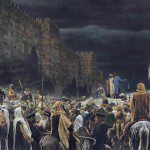
Weep with those who weep
Tears come at odd times. They don’t always come at the funeral, or at the site of the accident, or when a child is in pain. Sometimes they come days later, triggered by something as banal as a commercial or the words to a song on the radio. They come when I am, for reasons I can’t fully account for, ready to cry.
I didn’t weep at the moment my mother died, though I was holding her hand as she took her last gentle breath. But later, over dinner, I wept as I carried a bowl of steaming vegetables to the table. I often go through the anniversary of a huge loss dry-eyed only to find myself weeping in an untimely and unseemly way when a stranger’s profile catches my eye and something in light around her goes straight to the place in my body where I carry the sorrow.
I manage mostly to read moving passages or poems aloud in classes without weeping, but on occasion I have to hand off the text and let someone else finish. My throat tightens in the middle of a perfectly ordinary passage–annoying and inconvenient. I’m not afraid of being unprofessional; I just want the students to hear the passage whole and clearly—all the words spoken and held for their moment in the air between us. I want my tears not to drown them.
Tears sometimes do get in the way. And sometimes they’re beside the point when there’s practical help to be given. Sometimes they’re self-indulgent. Or maudlin. Or, on the other hand, sometimes I’m just not ready to weep. A deep, interior, mysterious process I don’t control has to come to its completion first.
I think now and then of Dilsey’s tears–the old African-American servant in Falkner’s The Sound and the Fury. She has endured; she has “seed de first en de last,” has held a profoundly dysfunctional white family together for more than a generation, has lived a life of thankless service for decades, practical, miraculously compassionate, guided by her own authority and a faith she never mentions except on Sundays when she goes to hear the Rev. Shegog preach. There she sits and listens and weeps.
As a white man, Faulkner’s access to the suffering of an old black female servant was, he acknowledged, limited. But he gives us her tears. As she listens to the Rev. Sheegog’s sermon, claiming the power of the blood of the Lamb, what she has suffered emerges in the safe space of a worshiping community where she can lay her burden down. As readers, we become aware that we are almost intruders upon the intimacies of her pain which, though public, is as utterly personal as the wracked and worn body that sags beneath the purple Easter dress in which she appears, iconic and, he would say, indomitable. Dilsey’s weeping “signifies,” in the antique sense of bringing forth meaning in the story she inhabits. For her to suffer is to act, and her suffering is the only redemptive action in this whole bleak tale of spiritual squalor.
Her tears are a consummation. They seem not so much to have been suppressed as kept for this time and place where they can be shed and seen in the context of others who know her suffering.
Reading about that service I remember times when I have witnessed others’ sorrow and wondered what right I had to enter into it. We may be called to weep with those who weep. Or, sometimes, to steal away quietly, leaving them to make their offering of tears only to God.












